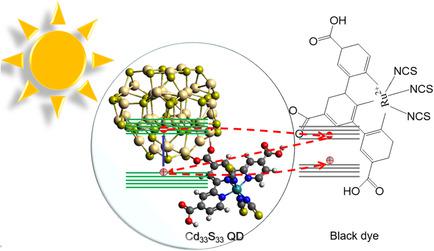当前位置:
X-MOL 学术
›
Energy Technol.
›
论文详情
Our official English website, www.x-mol.net, welcomes your feedback! (Note: you will need to create a separate account there.)
Effect of Adsorption Structure upon Directional Charge Transfer and Electronic Coupling in a Hybrid Dye Sensitizer based on a Cadmium Sulfide Quantum Dot
Energy Technology ( IF 3.8 ) Pub Date : 2021-09-18 , DOI: 10.1002/ente.202100565 Peng Cui 1 , Xiaolin Zhu 2 , Yuan Xue 1
Energy Technology ( IF 3.8 ) Pub Date : 2021-09-18 , DOI: 10.1002/ente.202100565 Peng Cui 1 , Xiaolin Zhu 2 , Yuan Xue 1
Affiliation

|
Dye-functionalized quantum dots (QDs) show promise for solar photovoltaic and photocatalytic applications. However, the energy conversion efficiencies are very sensitive to the chemical environment at the QD–dye interface, which is dependent upon how the QDs and dye interact. Herein, the effect of different surface orientations for an N749 dye attached to a CdS QD upon QD–dye interactions is investigated. The results reveal that the electronic couplings for binding configurations that involve isothiocyanate anchors are generally larger than those involving carboxylate anchors. Furthermore, for some binding modes, the electronic couplings for hole transfer are comparable to those for electron transfer, implying efficient charge separation at the QD–dye interface and reduced electron–hole recombination within the QD. It is also found that the most stable adsorption geometries for the dye are those with double carboxylate anchors, which exhibit weaker electronic coupling than isothiocyanate anchors and provide favorable energy alignment for hole transfer. Overall, the current computational study reveals some fundamental aspects concerning the relationship between interfacial charge transfer for QD/dye composites and their morphologies, such as the binding geometry of the dye, interfacial energetics and donor–acceptor interactions, which benefits the design of QD-based nanomaterials for photovoltaic and photocatalytic applications.
中文翻译:

吸附结构对基于硫化镉量子点的混合染料敏化剂中定向电荷转移和电子耦合的影响
染料功能化量子点 (QD) 显示出在太阳能光伏和光催化应用中的前景。然而,能量转换效率对 QD-染料界面处的化学环境非常敏感,这取决于 QD 和染料如何相互作用。在此,研究了连接到 CdS QD 的 N749 染料的不同表面取向对 QD-染料相互作用的影响。结果表明,涉及异硫氰酸盐锚的结合构型的电子耦合通常大于涉及羧酸盐锚的电子耦合。此外,对于某些结合模式,空穴传输的电子耦合与电子传输的电子耦合相当,这意味着 QD-染料界面处的有效电荷分离和 QD 内电子-空穴复合的减少。还发现染料最稳定的吸附几何结构是具有双羧酸盐锚的那些,其表现出比异硫氰酸盐锚更弱的电子耦合,并为空穴转移提供有利的能量排列。总体而言,当前的计算研究揭示了有关 QD/染料复合材料界面电荷转移与其形态之间关系的一些基本方面,例如染料的结合几何形状、界面能量学和供体-受体相互作用,这有利于 QD-基于纳米材料的光伏和光催化应用。
更新日期:2021-11-04
中文翻译:

吸附结构对基于硫化镉量子点的混合染料敏化剂中定向电荷转移和电子耦合的影响
染料功能化量子点 (QD) 显示出在太阳能光伏和光催化应用中的前景。然而,能量转换效率对 QD-染料界面处的化学环境非常敏感,这取决于 QD 和染料如何相互作用。在此,研究了连接到 CdS QD 的 N749 染料的不同表面取向对 QD-染料相互作用的影响。结果表明,涉及异硫氰酸盐锚的结合构型的电子耦合通常大于涉及羧酸盐锚的电子耦合。此外,对于某些结合模式,空穴传输的电子耦合与电子传输的电子耦合相当,这意味着 QD-染料界面处的有效电荷分离和 QD 内电子-空穴复合的减少。还发现染料最稳定的吸附几何结构是具有双羧酸盐锚的那些,其表现出比异硫氰酸盐锚更弱的电子耦合,并为空穴转移提供有利的能量排列。总体而言,当前的计算研究揭示了有关 QD/染料复合材料界面电荷转移与其形态之间关系的一些基本方面,例如染料的结合几何形状、界面能量学和供体-受体相互作用,这有利于 QD-基于纳米材料的光伏和光催化应用。


























 京公网安备 11010802027423号
京公网安备 11010802027423号